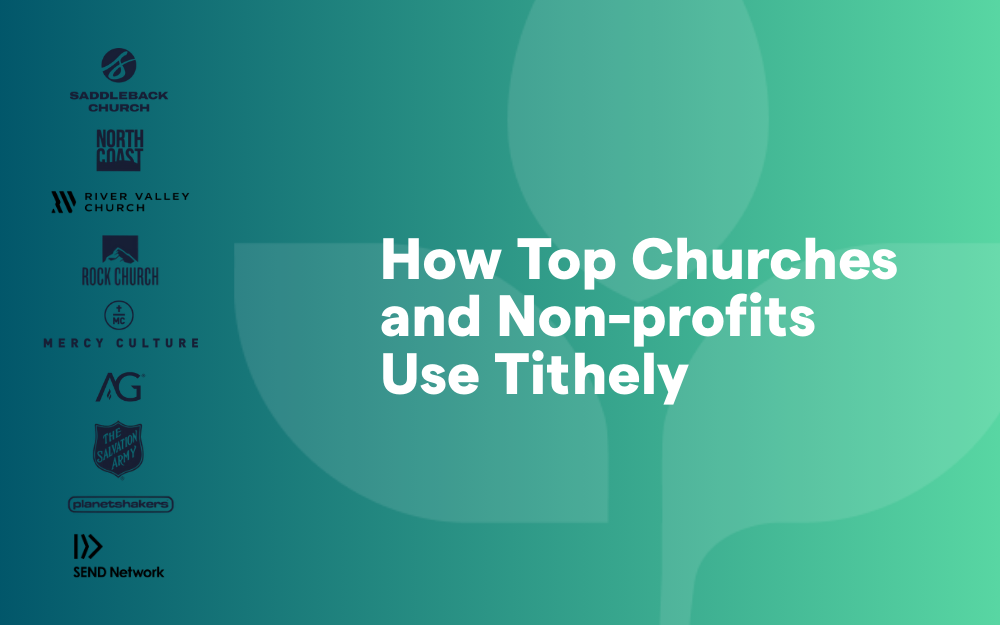Creating a Culture of Generosity
Shifting a church culture towards digital giving requires scriptural understanding and continuous education on generosity.

How to Create a Culture of Generosity
Maybe, as a church, you’ve dipped your toe into the world of digital giving. Perhaps your website is equipped to take credit card payments, but you’ve never really gone all in on a mobile giving platform like Tithe.ly or one of our competitors.
That’s actually wonderful news! You now stand before a great opportunity to change the culture of your church for years to come. This could be the beginning of a whole new adventure in following Jesus toward greater generosity as a local body of believers.
Over the years, I’ve learned that shifts in culture, especially within a church, don’t happen overnight, nor do they happen spontaneously. They are planned and are usually initiated by the leadership of a congregation. To fully embrace digital giving, it helps to understand some scriptural principles first.
Scriptural Understanding of Digital Giving
In the business world, the underlying motivation for existence is to make a profit. Whether you’re leading a firm that makes umbrellas, automobiles, or next-generation rocket engines, the bottom line is, well, the bottom line.
Not so with a church. Churches are nonprofit, and that sometimes means Christians push financial concerns to the side. But let’s remember the marching orders Jesus left His disciples.
He said, “Go and make disciples of all nations, baptizing them in the name of the Father and of the Son and of the Holy Spirit, and teaching them to obey everything I have commanded you” (Matthew 28:19–20).
The mission we’ve been given is a big one! We are to go into ALL THE WORLD—and that takes resources, financial and otherwise. If we are serious about doing our part to fulfill the great commission, it will take financial resources to get there.
This doesn’t mean that every church should be a mega-church, but in my mind it does mean that every church should desire to grow, to reach more people, and to make a bigger impact on their community and the world.
Well-meaning Christians can disagree on whether tithing is a practice that should be continued by believers today, but all Christians should agree that God wants His people to be sacrificial givers. In that sense, generosity is about more than the money collected; it’s about our hearts.
Jesus said, “No one can serve two masters. Either you will hate the one and love the other, or you will be devoted to the one and despise the other. You cannot serve both God and money” (Matthew 6:24).
When we begin to understand what Jesus’ sacrifice on the cross meant, we begin to realize that everything we have, everything we are, and everything we do belongs to Him. We are simply stewards, managers, and servants of all that we’ve been given. The money we earn and the money we’ve collected in our bank accounts belong to the King.
Having a biblical understanding of generosity is a good first step to changing the culture behind digital giving. It’s important for pastors and leaders to walk through Scripture and come to a clear understanding of Jesus’ calling in doing the work of the kingdom here on earth.
Once the leaders of your group have a keen understanding in scripture for financial giving, including the tithe, it’s important to effectively teach these principles to everyone in the congregation—not just one time, or for a single sermon series, but in a sustainable and continuous way. If you, as a pastor or church leader, can communicate your heart and vision for increased generosity, people will follow.
Sign Up for Product Updates
How to Create a Culture of Generosity
Maybe, as a church, you’ve dipped your toe into the world of digital giving. Perhaps your website is equipped to take credit card payments, but you’ve never really gone all in on a mobile giving platform like Tithe.ly or one of our competitors.
That’s actually wonderful news! You now stand before a great opportunity to change the culture of your church for years to come. This could be the beginning of a whole new adventure in following Jesus toward greater generosity as a local body of believers.
Over the years, I’ve learned that shifts in culture, especially within a church, don’t happen overnight, nor do they happen spontaneously. They are planned and are usually initiated by the leadership of a congregation. To fully embrace digital giving, it helps to understand some scriptural principles first.
Scriptural Understanding of Digital Giving
In the business world, the underlying motivation for existence is to make a profit. Whether you’re leading a firm that makes umbrellas, automobiles, or next-generation rocket engines, the bottom line is, well, the bottom line.
Not so with a church. Churches are nonprofit, and that sometimes means Christians push financial concerns to the side. But let’s remember the marching orders Jesus left His disciples.
He said, “Go and make disciples of all nations, baptizing them in the name of the Father and of the Son and of the Holy Spirit, and teaching them to obey everything I have commanded you” (Matthew 28:19–20).
The mission we’ve been given is a big one! We are to go into ALL THE WORLD—and that takes resources, financial and otherwise. If we are serious about doing our part to fulfill the great commission, it will take financial resources to get there.
This doesn’t mean that every church should be a mega-church, but in my mind it does mean that every church should desire to grow, to reach more people, and to make a bigger impact on their community and the world.
Well-meaning Christians can disagree on whether tithing is a practice that should be continued by believers today, but all Christians should agree that God wants His people to be sacrificial givers. In that sense, generosity is about more than the money collected; it’s about our hearts.
Jesus said, “No one can serve two masters. Either you will hate the one and love the other, or you will be devoted to the one and despise the other. You cannot serve both God and money” (Matthew 6:24).
When we begin to understand what Jesus’ sacrifice on the cross meant, we begin to realize that everything we have, everything we are, and everything we do belongs to Him. We are simply stewards, managers, and servants of all that we’ve been given. The money we earn and the money we’ve collected in our bank accounts belong to the King.
Having a biblical understanding of generosity is a good first step to changing the culture behind digital giving. It’s important for pastors and leaders to walk through Scripture and come to a clear understanding of Jesus’ calling in doing the work of the kingdom here on earth.
Once the leaders of your group have a keen understanding in scripture for financial giving, including the tithe, it’s important to effectively teach these principles to everyone in the congregation—not just one time, or for a single sermon series, but in a sustainable and continuous way. If you, as a pastor or church leader, can communicate your heart and vision for increased generosity, people will follow.
podcast transcript
How to Create a Culture of Generosity
Maybe, as a church, you’ve dipped your toe into the world of digital giving. Perhaps your website is equipped to take credit card payments, but you’ve never really gone all in on a mobile giving platform like Tithe.ly or one of our competitors.
That’s actually wonderful news! You now stand before a great opportunity to change the culture of your church for years to come. This could be the beginning of a whole new adventure in following Jesus toward greater generosity as a local body of believers.
Over the years, I’ve learned that shifts in culture, especially within a church, don’t happen overnight, nor do they happen spontaneously. They are planned and are usually initiated by the leadership of a congregation. To fully embrace digital giving, it helps to understand some scriptural principles first.
Scriptural Understanding of Digital Giving
In the business world, the underlying motivation for existence is to make a profit. Whether you’re leading a firm that makes umbrellas, automobiles, or next-generation rocket engines, the bottom line is, well, the bottom line.
Not so with a church. Churches are nonprofit, and that sometimes means Christians push financial concerns to the side. But let’s remember the marching orders Jesus left His disciples.
He said, “Go and make disciples of all nations, baptizing them in the name of the Father and of the Son and of the Holy Spirit, and teaching them to obey everything I have commanded you” (Matthew 28:19–20).
The mission we’ve been given is a big one! We are to go into ALL THE WORLD—and that takes resources, financial and otherwise. If we are serious about doing our part to fulfill the great commission, it will take financial resources to get there.
This doesn’t mean that every church should be a mega-church, but in my mind it does mean that every church should desire to grow, to reach more people, and to make a bigger impact on their community and the world.
Well-meaning Christians can disagree on whether tithing is a practice that should be continued by believers today, but all Christians should agree that God wants His people to be sacrificial givers. In that sense, generosity is about more than the money collected; it’s about our hearts.
Jesus said, “No one can serve two masters. Either you will hate the one and love the other, or you will be devoted to the one and despise the other. You cannot serve both God and money” (Matthew 6:24).
When we begin to understand what Jesus’ sacrifice on the cross meant, we begin to realize that everything we have, everything we are, and everything we do belongs to Him. We are simply stewards, managers, and servants of all that we’ve been given. The money we earn and the money we’ve collected in our bank accounts belong to the King.
Having a biblical understanding of generosity is a good first step to changing the culture behind digital giving. It’s important for pastors and leaders to walk through Scripture and come to a clear understanding of Jesus’ calling in doing the work of the kingdom here on earth.
Once the leaders of your group have a keen understanding in scripture for financial giving, including the tithe, it’s important to effectively teach these principles to everyone in the congregation—not just one time, or for a single sermon series, but in a sustainable and continuous way. If you, as a pastor or church leader, can communicate your heart and vision for increased generosity, people will follow.
VIDEO transcript
How to Create a Culture of Generosity
Maybe, as a church, you’ve dipped your toe into the world of digital giving. Perhaps your website is equipped to take credit card payments, but you’ve never really gone all in on a mobile giving platform like Tithe.ly or one of our competitors.
That’s actually wonderful news! You now stand before a great opportunity to change the culture of your church for years to come. This could be the beginning of a whole new adventure in following Jesus toward greater generosity as a local body of believers.
Over the years, I’ve learned that shifts in culture, especially within a church, don’t happen overnight, nor do they happen spontaneously. They are planned and are usually initiated by the leadership of a congregation. To fully embrace digital giving, it helps to understand some scriptural principles first.
Scriptural Understanding of Digital Giving
In the business world, the underlying motivation for existence is to make a profit. Whether you’re leading a firm that makes umbrellas, automobiles, or next-generation rocket engines, the bottom line is, well, the bottom line.
Not so with a church. Churches are nonprofit, and that sometimes means Christians push financial concerns to the side. But let’s remember the marching orders Jesus left His disciples.
He said, “Go and make disciples of all nations, baptizing them in the name of the Father and of the Son and of the Holy Spirit, and teaching them to obey everything I have commanded you” (Matthew 28:19–20).
The mission we’ve been given is a big one! We are to go into ALL THE WORLD—and that takes resources, financial and otherwise. If we are serious about doing our part to fulfill the great commission, it will take financial resources to get there.
This doesn’t mean that every church should be a mega-church, but in my mind it does mean that every church should desire to grow, to reach more people, and to make a bigger impact on their community and the world.
Well-meaning Christians can disagree on whether tithing is a practice that should be continued by believers today, but all Christians should agree that God wants His people to be sacrificial givers. In that sense, generosity is about more than the money collected; it’s about our hearts.
Jesus said, “No one can serve two masters. Either you will hate the one and love the other, or you will be devoted to the one and despise the other. You cannot serve both God and money” (Matthew 6:24).
When we begin to understand what Jesus’ sacrifice on the cross meant, we begin to realize that everything we have, everything we are, and everything we do belongs to Him. We are simply stewards, managers, and servants of all that we’ve been given. The money we earn and the money we’ve collected in our bank accounts belong to the King.
Having a biblical understanding of generosity is a good first step to changing the culture behind digital giving. It’s important for pastors and leaders to walk through Scripture and come to a clear understanding of Jesus’ calling in doing the work of the kingdom here on earth.
Once the leaders of your group have a keen understanding in scripture for financial giving, including the tithe, it’s important to effectively teach these principles to everyone in the congregation—not just one time, or for a single sermon series, but in a sustainable and continuous way. If you, as a pastor or church leader, can communicate your heart and vision for increased generosity, people will follow.




























